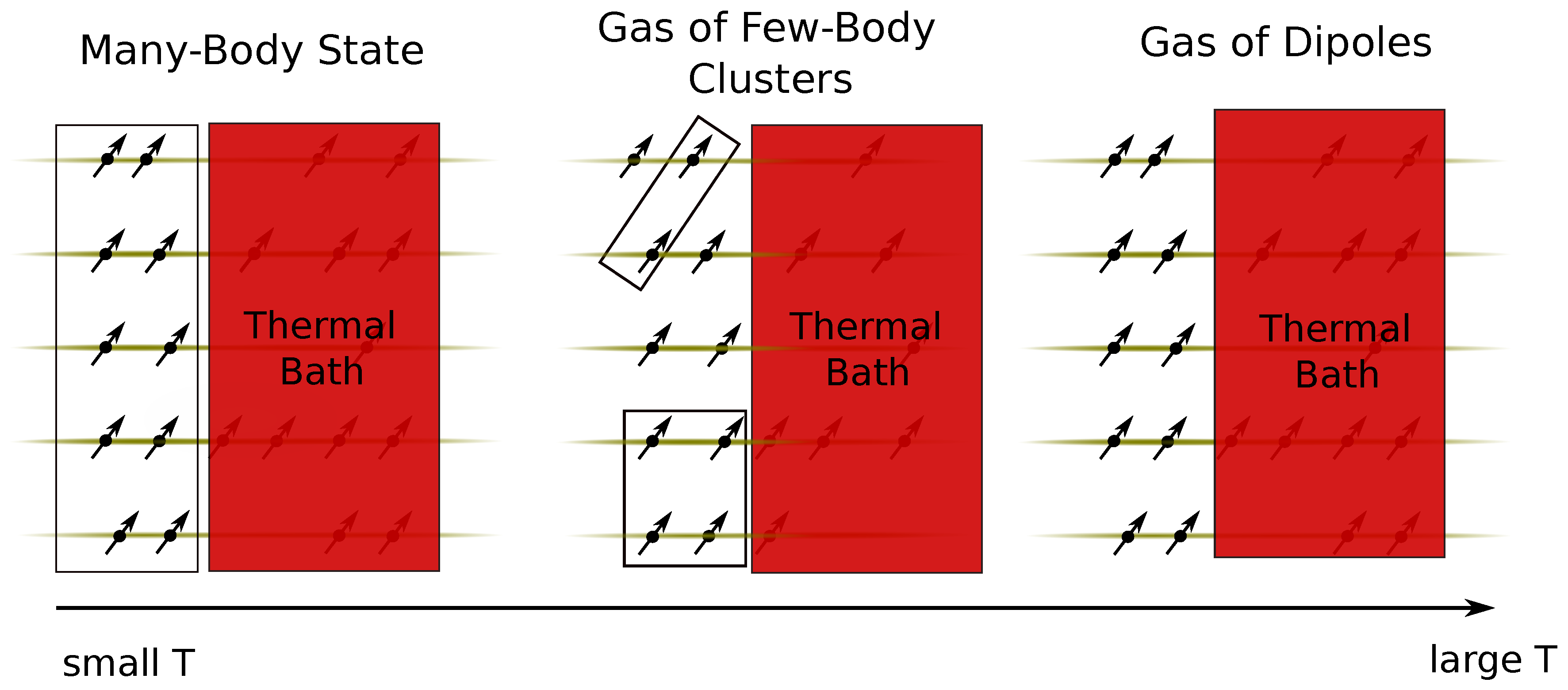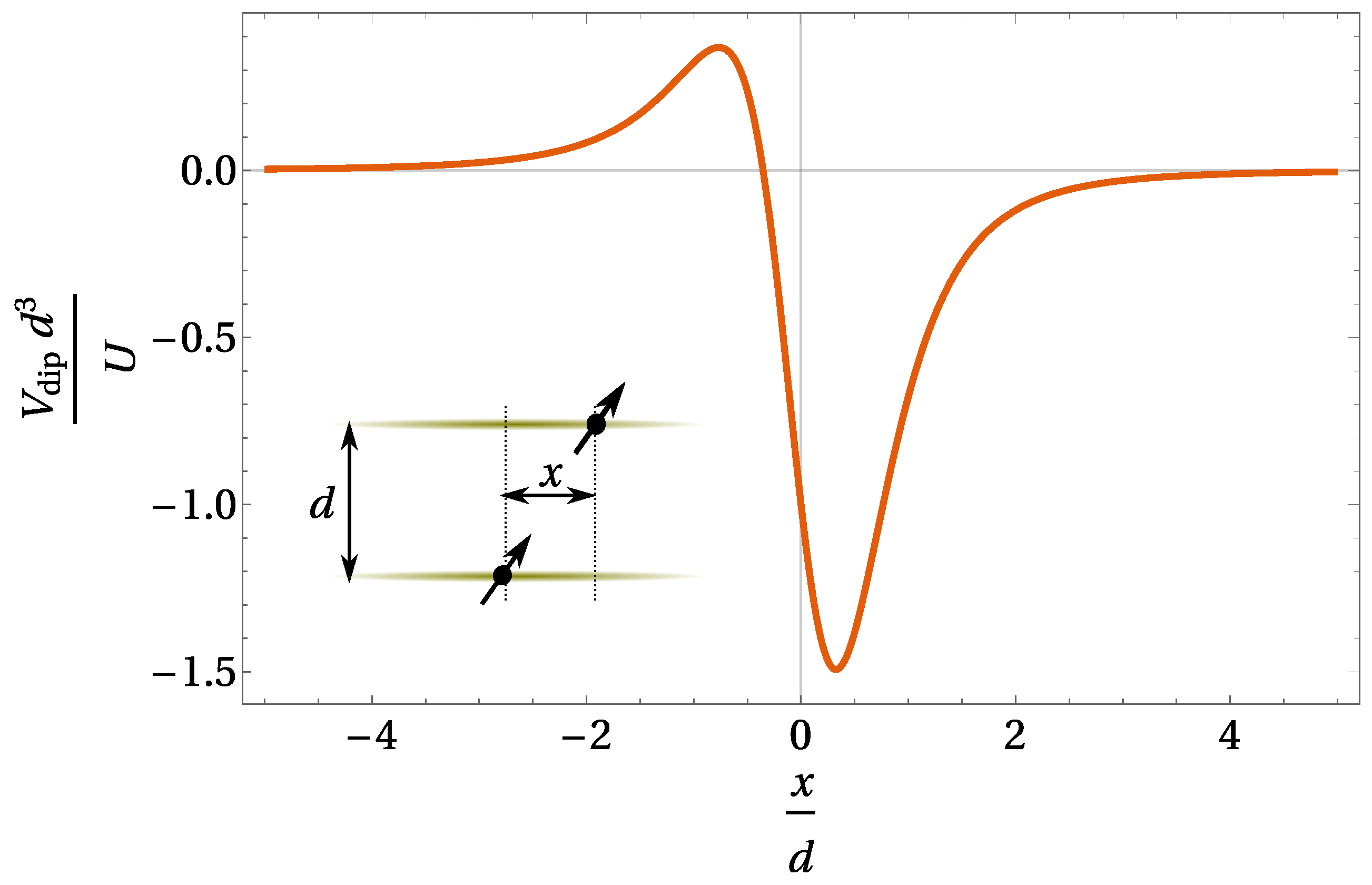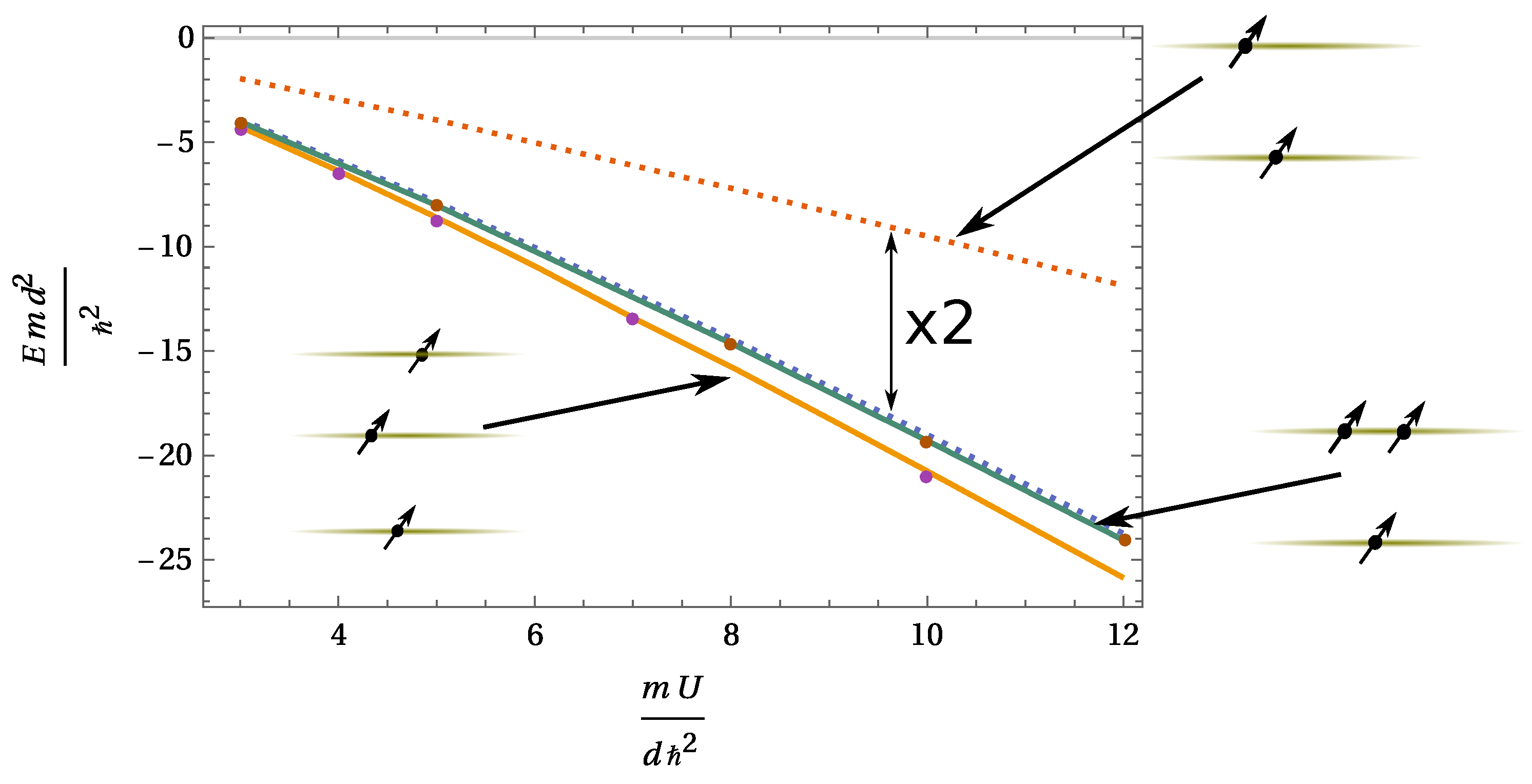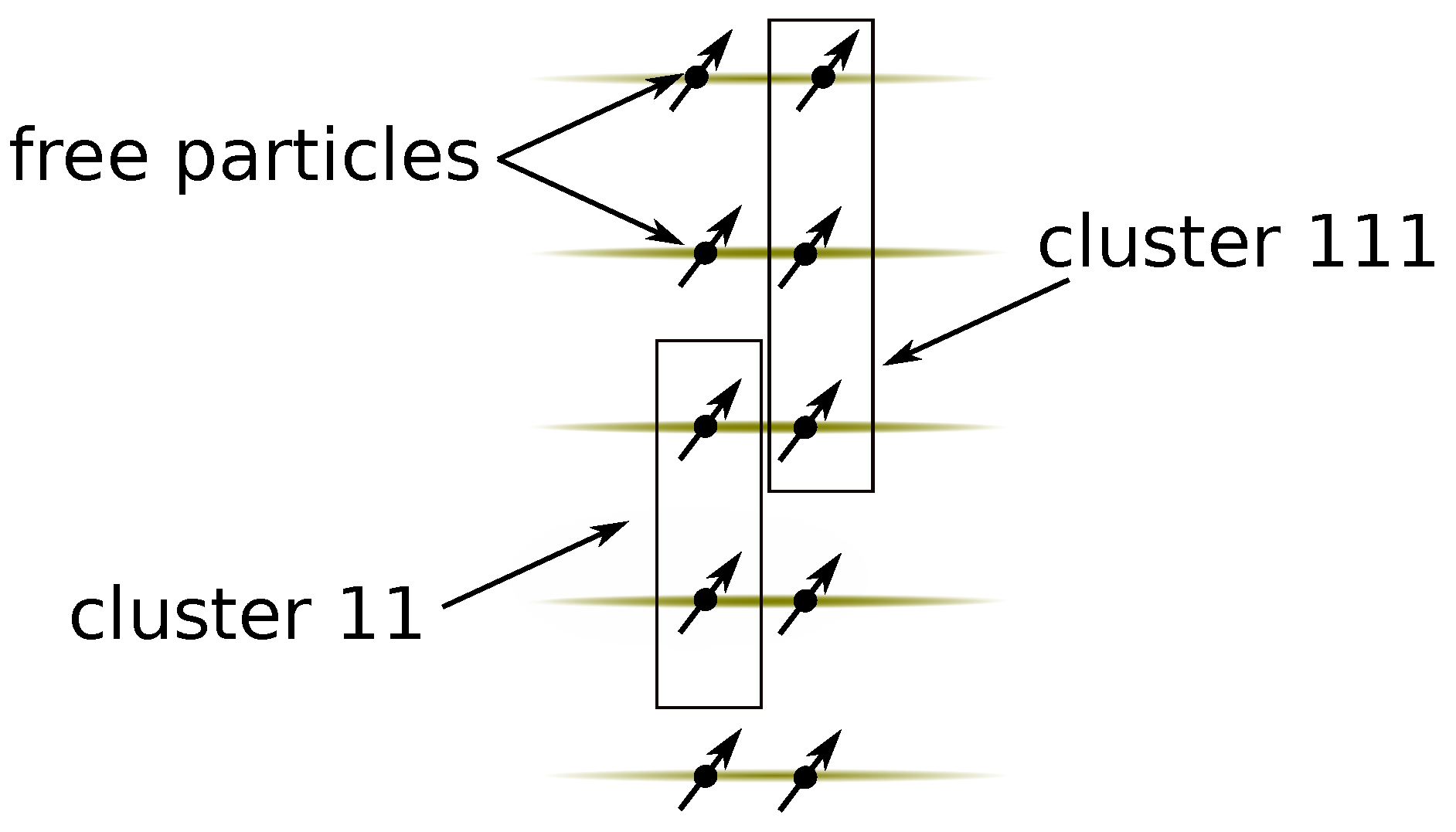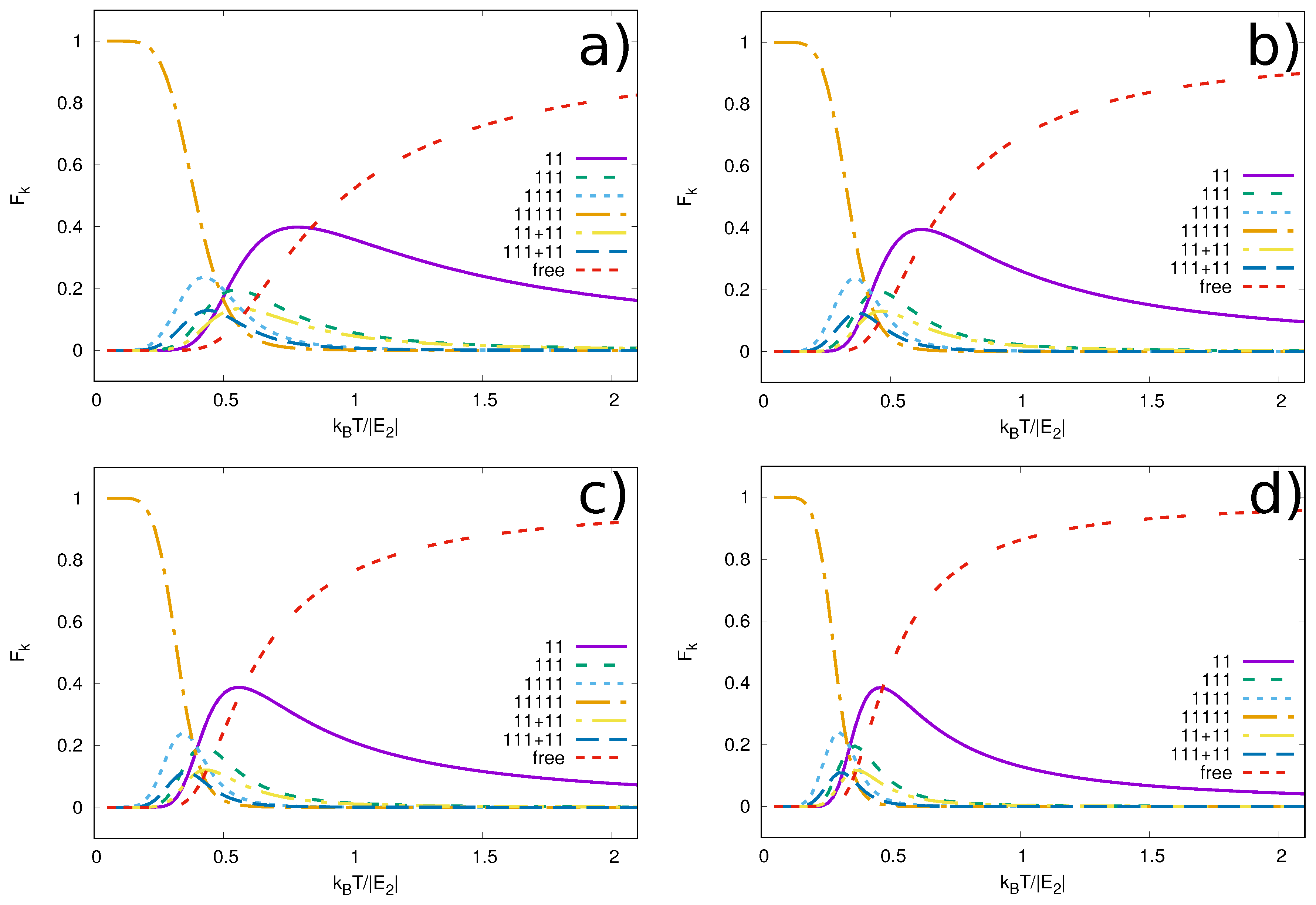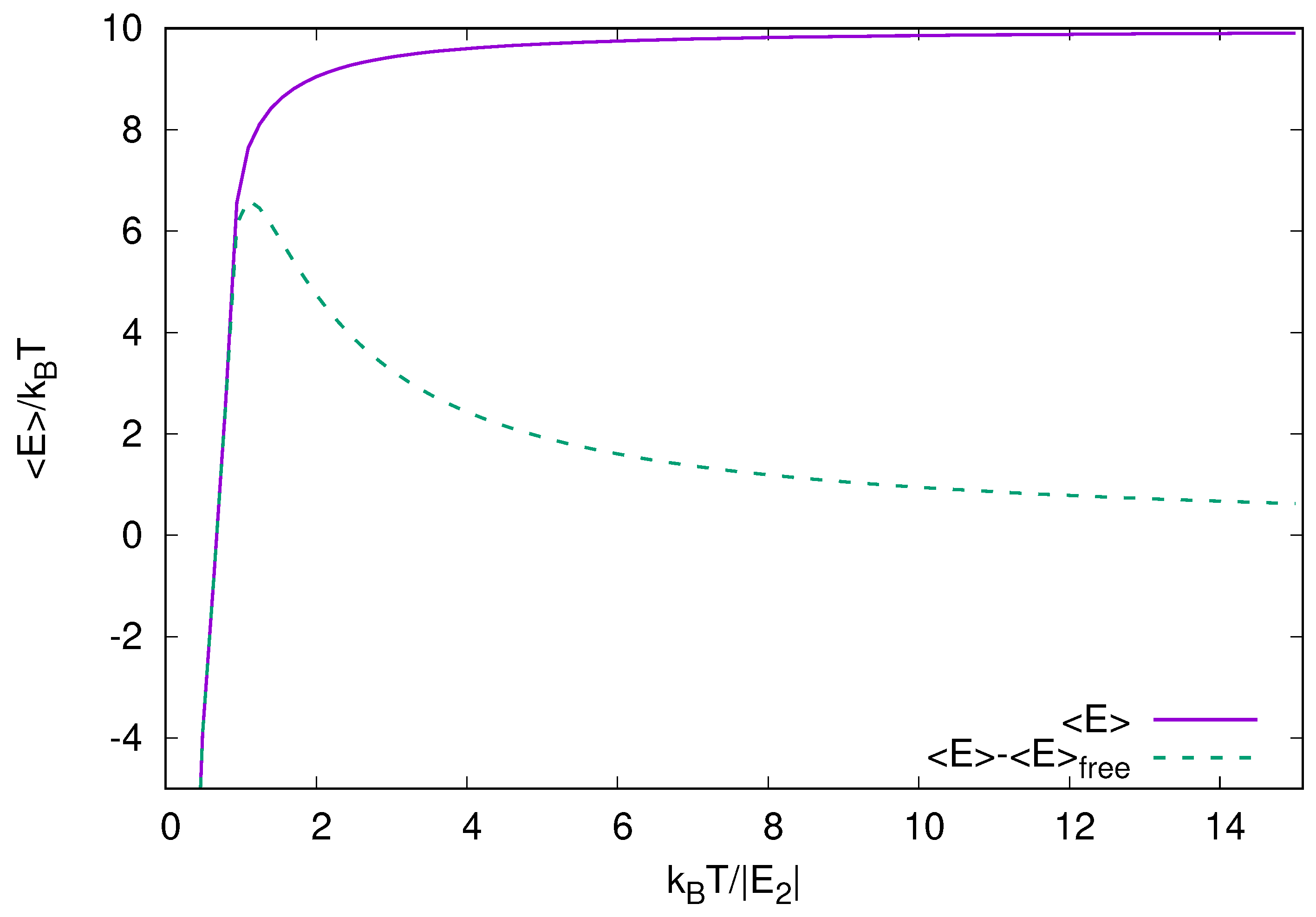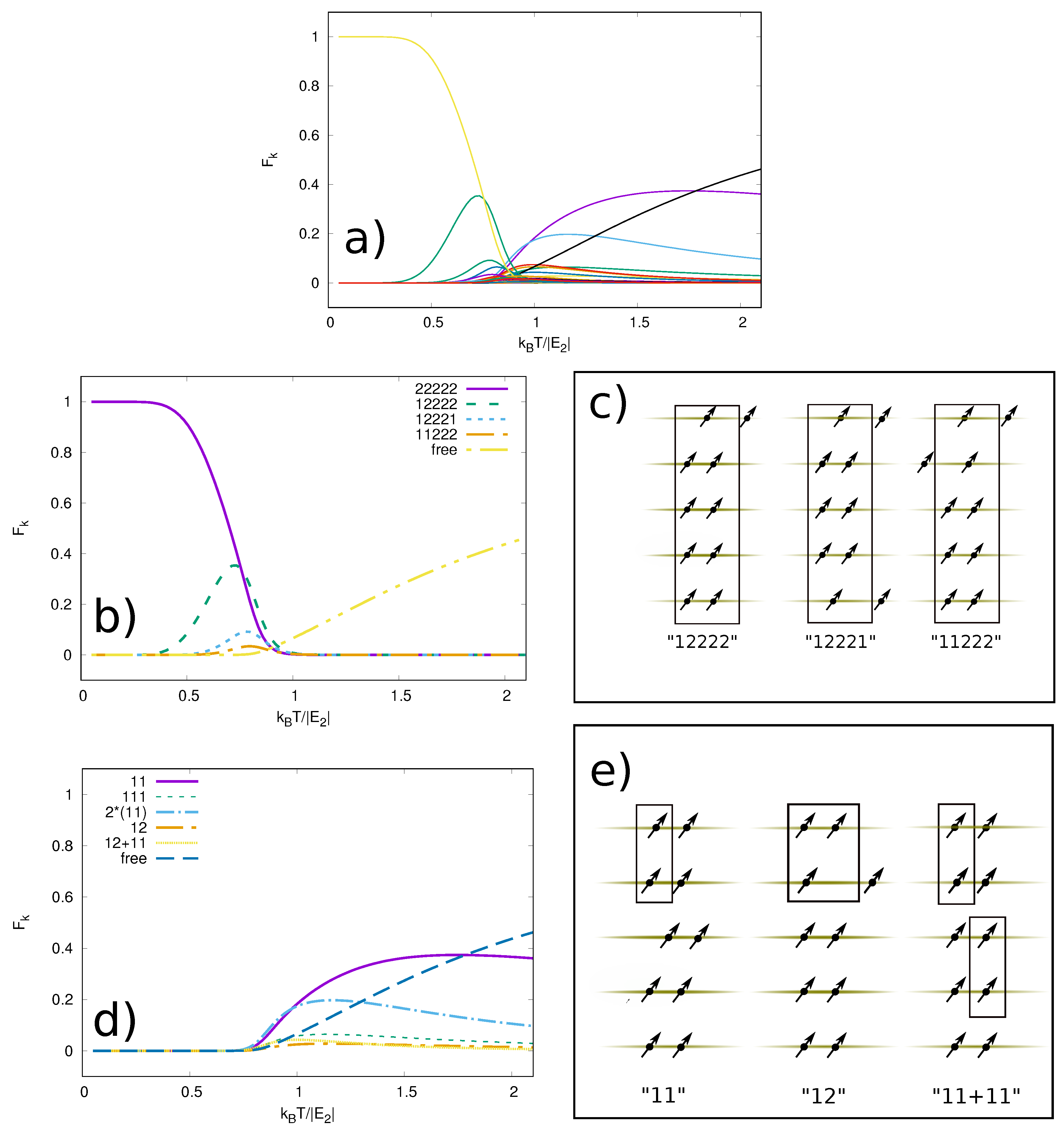1. Introduction
One important question that quantum few-body physics should answer is under which conditions few-body bound states play a role (or could be observed) in a many-body system. It is clear that if the energy associated with the temperature is much larger than the few-body binding energy, then bound states occupy a tiny fraction of the Hilbert space, and hence the probability to observe (populate) a bound state is exponentially suppressed. Think, for example, about Efimov states [
1] (see References [
2,
3,
4,
5] for a review) in cold-atom systems. These states are always present in a cold gas; however, only at ultracold temperatures is it possible to observe them [
6].
In this paper, we study at which temperatures few-body bound states can be observed in a cold gas of dipoles (see [
7,
8], which review cold dipolar gases), once precise control of cold polar molecules is achieved [
9]. Our model is the system illustrated in
Figure 1. The dipoles are trapped by an optical lattice, which can be formed, for example, by superimposing two orthogonal standing waves [
10]. Strong trapping prevents particles from tunneling between the tubes, so the system can be approximated as a collection of one-dimensional tubes. An external electric field controls the alignment of the dipoles. Previous works investigated the formation of chains in two-dimensional geometries [
11]. We are interested in formation of few-body states with more than one particle per layer (or tube), which are unlikely to be observed for dipoles with perpendicular polarization [
12]. Therefore, we assume that the dipoles are tilted to the “magic angle” such that there is no interaction within a tube, see, References [
12,
13] for a discussion of few-body bound states with other polarizations. Still the long-range dipole-dipole interaction allows particles to interact between the layers. This interaction supports a zoo of few-body bound states [
12,
13,
14,
15], whose presence should be taken into account when building models of the corresponding many-body systems (see, for example, [
11,
16,
17,
18,
19]).
To find at which temperature these states enter the description, we consider a system of dipoles coupled to a thermal bath. We assume that particles obey Boltzmann statistics, however, we will argue that our results are also applicable to systems of bosons. For the sake of discussion, we assume that the system is made of ten dipoles that occupy five tubes, see
Figure 1. In spite of its simplicity, we expect that this system contains all basic ingredients allowing us to learn about the formation of the simplest few-body clusters. This system has enough tubes so that particles in the outermost tubes do not interact with each other. Therefore, adding more tubes cannot qualitatively change our results. Moreover, the system has more than one particle per tube allowing us to investigate the effect of non-chain few-body structures. Our results show that these structures are not important for our analysis. In particular, our results show that there is a clear transition from a many-body bound state to a state dominated by chains of dipoles.
This paper is organized as follows. In
Section 2, we introduce the method used for computation of few-body energies. The partition function that determines the probability of a particular state is discussed in
Section 3. In
Section 4, we demonstrate at which temperatures few-body clusters can be observed. In
Section 5, we summarize our results and conclude.
2. Binding Energies of Clusters
The binding energy of a specific cluster can be obtained by diagonalizing the Hamiltonian
where
m is the mass of the dipolar particle, the subscript
refers to the
ith particle in the
th layer. The potential,
, describes the dipole-dipole interaction:
where
is the relative distance between the two dipoles,
determines the separation between the dipoles in the
z direction,
d is the distance between the adjacent tubes and
is the dipole moment of the
ith dipole in the
th layer. For simplicity, the width of a tube is taken to be zero (for finite widths, see References [
14,
20,
21]). By assumption, the dipole moment has only
x and
z components:
. Our choice for the tilting angle,
, will be discussed shortly. Therefore, we write
where
U determines the strength of the dipole-dipole interaction. Values of
U are in units of
unless otherwise noted.
It is complicated, if not impossible, to calculate exactly binding energies of
for large clusters of dipoles. Instead, we resort to a harmonic approximation. The model of choice, coupled quantum harmonic oscillators,
is exactly solvable [
22]. Here
is the reduced mass of the dipolar particles,
is the coupling frequency between particles in different layers (if
then
),
is the origin shift of the coupling frequency, and
is a constant energy shift. The parameter
is present because a spatially shifted oscillator more accurately reflects
, as the minimum of
, in general, does not occur at
(see
Figure 2).
The parameters of Equation (
4) should be adapted to the system of interest depicted in
Figure 1. Our philosophy is that the properties of two dipoles in adjacent layers should be reproduced by our oscillator model. The dipoles experience an overall attraction for
(i.e.,
), which leads to a two-body bound state in one spatial dimension at any interaction strength [
23,
24]. We would then like to use the energy of this two-body state, as well as its size, to determine the parameters of
:
,
and
. These parameters are obtained by variationally solving the exact Hamiltonian from Equation (
1) for two particles:
where
x is the relative in-tube distance between two dipoles.
To establish the coupling frequency between adjacent layers,
, and
we find the function of the Gaussian form,
, that minimizes the expectation value of
. We note that the function
is the ground state of the Hamiltonian from Equation (
4) for two particles, i.e.
whose frequency,
, is related to the variational parameter
A by
and
. The energy shift,
, is used in
to set the two-body energy at the correct position,
, where
is the exact ground state energy of
. We calculate this energy by solving the Schrödinger equation in coordinate space. We first use a lattice grid to discretize the kinetic energy operator, which leads to a linear system of equations. This system is then solved by matrix diagonalization. The error can be made arbitrarily small by increasing the number of points used for discretization. Therefore, all parameters of
for two particles are determined. To set the interactions that appear in
beyond adjacent layers, we use the scaling properties (see Reference [
25]) of the dipole-dipole Hamiltonian (
5) to adjust the frequencies and shifts:
where the functions
,
, and
describe the dependence on the dipole strength of the frequency, origin shift, and two-body energy, respectively. They are obtained by following the variational procedure described above for a set of values of
U. The scaling properties are obtained by making the Hamiltonian dimensionless, by using the inter-layer distance,
d, as the unit of length, and then seeing how the different quantities scale with this distance. The dimensionless Schrödinger equation is
where
. From this equation, it can be seen that the dipole strength scales with
and that the energy must be scaled by
, affecting the shift as shown in Equation (9). Regarding the other two scaling relationships, the expectation value of a two-body Hamiltonian can be written as
which means that
, where
G is some function. Equations (
7) and (8) follow from the functional form of
.
For all our calculations, we consider the angle,
, to be the so-called “magic angle”,
. This is the angle where the intra-layer interaction,
, vanishes, and is determined by
(
). The inter-layer interaction is presented in
Figure 2. To explain our choice of angle, we discuss below what happens if
or
. If
, then there is attraction between particles within the layers. We do not consider this case further, because a many-body system of attractive dipoles collapses, i.e., the limit
is not a finite number (cf. Reference [
26] for bosons interacting with zero-range potentials). We note that one could stabilize the system of attractive bosons by including a short-range repulsion, see, e.g., theoretical works References [
27,
28,
29] inspired by recent observations of coherent droplets in dipolar systems [
30,
31,
32,
33]. We do not investigate this possibility here. For
, there is repulsion within the same tube and attraction between the tubes. We modeled this system with two-dimensional layers before [
25] with an inverted oscillator representing the repulsion. While this reasonably modeled how such a system might fall apart, the inverted oscillator was difficult to constrain, and we sought a more realistic way of representing the repulsion. With the results found in [
34,
35,
36,
37], showing that we could treat the individual layers separately, we inserted the exact repulsion in the in-layer energies, coupled with harmonic attraction between the layers. This treatment failed to agree with earlier SVM calculations in Reference [
12]. For example, it was found that even at 55
(just past the “magic angle”), the oscillator model had energies that were noticeably different from what was calculated before. This happened because the long-range in-layer dipole-dipole repulsion pushes the particles far from each other into the region, where the harmonic oscillator does not reproduce well the intra-layer attraction. Therefore, in the present work, calculations are performed at the “magic angle” only.
Now all parameters of
are determined (note that
from Equation (
4) is the sum of all the
for all pairs). We can move on to calculating energies of clusters. However, before that, we note that there are other ways to determine the parameters of
. One could, for example, avoid using
and establish frequencies variationally, similar to two-dimensional calculations of Reference [
11]. An advantage of such an approach would be that the obtained energies rigorously establish an upper bound on the energy. A disadvantage of neglecting
would be that a Gaussian wave function fails to describe weakly bound states. For example, it predicts a critical value for two-body binding in two spatial dimensions [
11]. One could also estimate the parameters of
from
(see
Figure 2) using the limit of large
U, i.e., when particles move only in the vicinity of the potential minimum. The interaction potential close to its minimum can be written as
where
determines the position of the minimum of
. This expansion leads to an estimate of the ground state energy
the first two terms here are calculated using the first two terms in the expansion in Equation (
12), the last term is calculated considering the last terms in Equation (
12) as perturbations. According to this estimate,
can be approximated by a harmonic oscillator potential if
, which is not satisfied for parameter regimes we consider below. We leave an exploration of different ways to determine parameters of
to future studies. Instead, we compare the energies from our oscillator model to the exact results.
For convenience, we first introduce the labeling for bound states (see
Figure 3): 11 means a bound state made of two particles in adjacent layers, 12 refers to two particles in one layer and a single particle in the adjacent layer, 111 is a bound state of three particles with one particle per tube, etc. After determining all parameters of the oscillator model, we compare the ground state energies of free (no external trap) few-body systems obtained in the oscillator model with results calculated with the stochastic variational method (SVM) (for the description of the method see [
38,
39]).
These comparisons can be seen in
Figure 3; we also tabulate energies for certain values of
U in
Table 1. The harmonic oscillator and variationally obtained results are indeed very close in all cases. This is also demonstrated in
Figure 3, where the results of the two methods are compared. They agree very well, with the worse comparisons within about 1.5%. Similar comparisons for chains of dipoles can be found in Reference [
12]. For our further calculations, we will use only the ground state energies of
. We assume that for a given cluster, the population of all bound excited states is negligible in comparison to the population of the ground state. To validate this assumption, we note that for small values of
U there are no excited states. We find numerically that the first excited bound state for two particles in two adjacent layers appears at
. The excited states remain weakly bound for all considered values of
U. For example, for
, the ground state is about
times more bound than the first excited state. Each weakly two-body state gives rise to a family of shallow few-body states. These states have small binding energies, which allows us to refrain from considering them here. Finally, let us give an estimate for the temperature scales that correspond to the calculated binding energies. We assume that
m and
, which leads to
for
, where
is the Boltzmann constant. Smaller values of
U require even smaller temperatures for observation of few-body clusters, therefore, in what follows we focus on
and
.
3. Abundances of Clusters
We consider five layers, each with two dipolar molecules (particles) inside. We assume that every particle is in the harmonic oscillator, . This can be either due to an external trapping potential, or a way to simulate a finite density of a many-body system. We then calculate the fractional occupancy of given clusters as a function of temperature. For simplicity, we assume that the particles are distinguishable, thus they obey Boltzmann statistics. We discuss this assumption in detail at the end of the next section.
Few-body clusters range from the simplest, a two-particle bound state of particles in adjacent layers, up to a bound state of all ten particles. We also include the possibility that all ten remain unbound, in which case the energies are approximately given by the energies of the states of the confining harmonic trap of the layer. The fractional occupancy of any state
k is
where
is the energy of state
k,
Z is the partition function and
. The partition function in the canonical ensemble is
where
is the degeneracy of the
kth energy. We write the energy of the various cluster configurations as a sum of two components:
The first component,
, is the binding energy of all clusters in the state
k, with
being the binding energy of the
jth cluster in the configuration
k. The first line in Equation (
16) also contains sums over all the various oscillator degrees of freedom in the configuration. The free particles are particles moving in the oscillator potential defined by
, with the corresponding energy levels and quantum numbers,
. The center of masses (CM) of the cluster(s) also have the same spectrum. To simplify notation, we introduce the quantum number
. The value of
defines how many oscillator degrees of freedom we have. To illustrate the decomposition of the energy
, let us consider the configuration
k presented in
Figure 4. This configuration has two clusters and five free particles. The energy
is the sum
. The value of
can take any integer value. It is given by the decomposition
, where
.
The energy,
, is obtained by using the harmonic approximation from the previous section. By construction,
is not affected by the harmonic oscillator potential,
, whose length is much larger than the size of the cluster. Please note that to write the energy
, we assume that the cluster-cluster and cluster-(free particle) interactions are negligible. This assumption relies on the two observations: (i) by construction, the harmonic oscillator length is much larger than the range of the dipole-dipole potential, therefore, for low-lying excited states we may approximate
with a zero-range interaction; (ii) the interaction due to a short-range potential can shift the energy by only about
. This statement relies on comparing the energies in a weakly interacting limit to that of a strongly interacting limit for zero-range interaction models, see, e.g., References [
40,
41]. This shift is not important for our qualitative discussion.
For a specific state, the CM and the free motion would also appear with specific quantum numbers. Since we are primarily interested in which specific clusters are prevalent at a given temperature, we then include all possible oscillator excitations by summing them up, so that the probability of a specific cluster configuration,
, is given by summing
from Equation (
14)
where
,
, along with the degeneracy
must be determined for each cluster configuration. The partition function, extracted from the condition that
, is then
As an example, consider the cluster configuration in
Figure 4. We have
, since there are five free particles, the CM of the 11 cluster, and the CM of the 111 cluster. The binding energy of the clusters is given by
. There are 176 ways to distribute the clusters 11 and 111 among five different layers. Therefore
, and furthermore, the probability to find a configuration with a single 11 cluster and a single 111 cluster is given by
where we introduced the convention that
means that the clusters
and
exist simultaneously in the system.
5. Summary and Conclusions
We study theoretically the temperature dependence of structures of dipoles trapped in equidistantly separated tubes. The dipoles are tilted by an external field to the “magic angle”, where the in-tube interaction is zero. The input that determines the probability to observe a few-body cluster at a given temperature is the set energies of the many different cluster configurations. To calculate these energies, we design an accurate method based on an oscillator approximation. We demonstrate the validity of the method, and apply it to calculate the energies of the different cluster configurations, and in turn to obtain the partition function as function of temperature.
We choose two rather simple systems to be studied in detail as function of temperature. The two systems have five tubes each with either one or two dipoles. We first calculate the temperature dependence of the average energies for different interactions and trap frequencies in comparison with the energies of the free-particle system. These dependencies are all qualitatively the same, i.e., changing from bound-state values to high-temperature statistical equilibrium values. However, finer details reveal weak dependence on the strength of interaction and the trapping frequency.
The number of different cluster configurations is relatively large even for the simple systems we choose to study here. The more detailed results of individual cluster occupancies are available through the partition function. We obtain the occupancies of the clusters by increasing the temperature from zero to much higher than the energy of a dimer formed by two dipoles in adjacent layers. These occupancies show a change of the system from the corresponding ground state towards entirely free particles. However, the details of this melting at moderate temperatures reveal how this process proceeds through intermediate configurations of various clusters. At temperatures around the dimer energy the configurations in the ensemble are mixed more than at any other temperature. Our findings show that even though there are many few-body clusters, most of them are unlikely to be detected in a many-body system. Indeed, the system shows a fast transition from a many-body state at low temperatures to a high-temperature state where only the simplest clusters (e.g., a dimer) play a role. This observation suggests that effective theories that include only free particles and dimers can accurately describe the system down to .
In conclusion, we have presented a method and derived results for the melting of one-dimensional systems of relatively few dipoles. The cluster structures are clearly very important in systems of many particles at moderate temperatures. This suggests a tool for investigating the transition from few- to many physics by changing the temperature in cold-atom systems.
In the future, it will be interesting to extend our results to more complicated systems that could have more particles and/or more tubes. For a more realistic calculation one should include a short-range intra-layer repulsive interaction even for dipoles at a “magic angle”. This interaction will decrease the probability to observe few-body structures that have more than one dipole per layer. Please note that an inclusion of a short-range interaction in Equation (
4) with at most two particles per layer still leads to a solvable model [
37]. One could study as well two-dimensional systems of layers of particles, which are known to support various few-body bound states [
42,
43,
44]. To increase the probability to observe non-chain few-body clusters, one should again consider tilting dipoles. It is impossible to find an angle that turns off completely the dipole-dipole interaction in a two-dimensional layer, which significantly complicates the problem.
